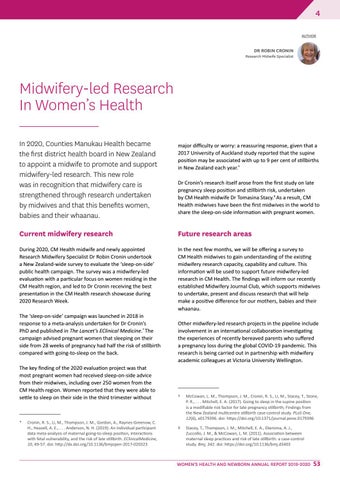4 AUTHOR
DR ROBIN CRONIN
Research Midwife Specialist
Midwifery-led Research In Women’s Health In 2020, Counties Manukau Health became the first district health board in New Zealand to appoint a midwife to promote and support midwifery-led research. This new role was in recognition that midwifery care is strengthened through research undertaken by midwives and that this benefits women, babies and their whaanau.
major difficulty or worry: a reassuring response, given that a 2017 University of Auckland study reported that the supine position may be associated with up to 9 per cent of stillbirths in New Zealand each year.† Dr Cronin’s research itself arose from the first study on late pregnancy sleep position and stillbirth risk, undertaken by CM Health midwife Dr Tomasina Stacy.‡ As a result, CM Health midwives have been the first midwives in the world to share the sleep-on-side information with pregnant women.
Current midwifery research
Future research areas
During 2020, CM Health midwife and newly appointed Research Midwifery Specialist Dr Robin Cronin undertook a New Zealand-wide survey to evaluate the ‘sleep-on-side’ public health campaign. The survey was a midwifery-led evaluation with a particular focus on women residing in the CM Health region, and led to Dr Cronin receiving the best presentation in the CM Health research showcase during 2020 Research Week.
In the next few months, we will be offering a survey to CM Health midwives to gain understanding of the existing midwifery research capacity, capability and culture. This information will be used to support future midwifery-led research in CM Health. The findings will inform our recently established Midwifery Journal Club, which supports midwives to undertake, present and discuss research that will help make a positive difference for our mothers, babies and their whaanau.
The ‘sleep-on-side’ campaign was launched in 2018 in response to a meta-analysis undertaken for Dr Cronin’s PhD and published in The Lancet’s EClinical Medicine.* The campaign advised pregnant women that sleeping on their side from 28 weeks of pregnancy had half the risk of stillbirth compared with going-to-sleep on the back. The key finding of the 2020 evaluation project was that most pregnant women had received sleep-on-side advice from their midwives, including over 250 women from the CM Health region. Women reported that they were able to settle to sleep on their side in the third trimester without
*
Cronin, R. S., Li, M., Thompson, J. M., Gordon, A., Raynes-Greenow, C. H., Heazell, A. E., . . . Anderson, N. H. (2019). An individual participant data meta-analysis of maternal going-to-sleep position, interactions with fetal vulnerability, and the risk of late stillbirth. EClinicalMedicine, 10, 49-57. doi: http://dx.doi.org/10.1136/bmjopen-2017-020323
Other midwifery-led research projects in the pipeline include involvement in an international collaboration investigating the experiences of recently bereaved parents who suffered a pregnancy loss during the global COVID-19 pandemic. This research is being carried out in partnership with midwifery academic colleagues at Victoria University Wellington.
†
McCowan, L. M., Thompson, J. M., Cronin, R. S., Li, M., Stacey, T., Stone, P. R., . . . Mitchell, E. A. (2017). Going to sleep in the supine position is a modifiable risk factor for late pregnancy stillbirth; Findings from the New Zealand multicentre stillbirth case-control study. PLoS One, 12(6), e0179396. doi: https://doi.org/10.1371/journal.pone.0179396
‡
Stacey, T., Thompson, J. M., Mitchell, E. A., Ekeroma, A. J., Zuccollo, J. M., & McCowan, L. M. (2011). Association between maternal sleep practices and risk of late stillbirth: a case-control study. Bmj, 342. doi: https://doi.org/10.1136/bmj.d3403
WOMEN'S HEALTH AND NEWBORN ANNUAL REPORT 2019-2020 53






















